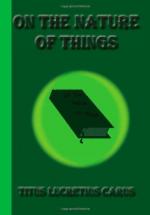|
This section contains 194 words (approx. 1 page at 400 words per page) |

|
First century B.C.: Lucretius' De rerum natura describes atoms as the invisible, solid, indivisible building blocks of all matter.
Sixteenth and seventeenth centuries: Experimental science gains popularity, and atomic theory begins to make important strides. Chemists discover that matter can be identified by its separate components. For example, water can be identifi ed as being composed of hydrogen and oxygen.
1930s: The electron microscope is developed, a tool that would eventually allow scientists to see particles as small as atoms.
First century B.C. Rome: Most Romans believe that gods and goddesses govern natural occurrences and manipulate human affairs. In order to appease the gods and goddesses and win their favor, worshippers must create altars and, sometimes, make sacrifices.
Twentieth-century United States: Statistics compiled in 1996 by the United States Census indicate that 56% of Americans practice Protestantism, 25% practice Roman Catholicism, and 11% practice no religion...
|
This section contains 194 words (approx. 1 page at 400 words per page) |

|




